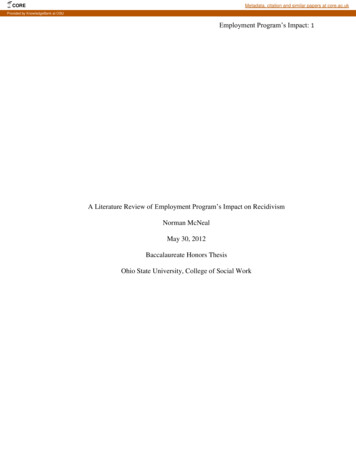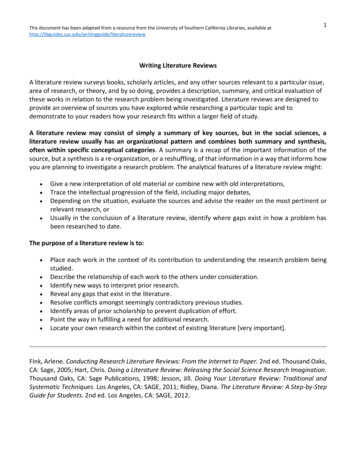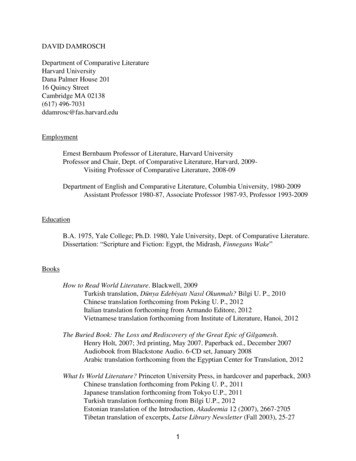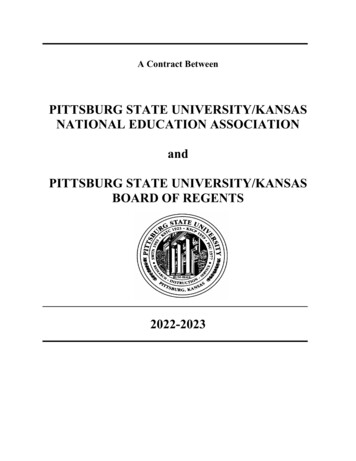
Transcription
COREMetadata, citation and similar papers at core.ac.ukProvided by KnowledgeBank at OSUEmployment Program’s Impact: 1A Literature Review of Employment Program’s Impact on RecidivismNorman McNealMay 30, 2012Baccalaureate Honors ThesisOhio State University, College of Social Work
Employment Program’s Impact: 2Table of ContentsChapterIProblem Statement 4-7IITheoretic Frameworks 7-9IIIBackground 9-11IVLiterature Review .11-2222-26VVIImplications .Conclusion .26-27References 28-31
Employment Program’s Impact: 3AbstractThis literature review considers the impact of employment programs on recidivism. Therehas been a dramatic rise in the numbers of those who have histories of incarceration inthe United States. A review of the literature in this area of research reveals that many ofthe evaluations end with findings of “no statistical significance” concerning the effect ofemployment programs for ex-offenders on recidivism. This review concludes bysuggesting that experimental and quasi experimental research may yield findings ofgreater impacts toward reducing recidivism and showing more instances of statisticalsignificance. Specifically there is the need for the following: 1) Research on the impact ofemployment programs on recidivism needs to be conducted in fields with nonexclusionary hiring policies and hiring practices toward ex-offenders. 2) Employmentprograms offering financial assistance must be at a level that does not provide adisincentive to work. 3) Job placements offered by employment programs should be forwork offering livable wages (not minimum wage). 4) Employment programs need tooffer individualized treatment based on relevant variables such as age, marital status,race, risk level and length of incarceration. 5) Employment programs should offer acognitive behavioral/thinking intervention as part of their services.
Employment Program’s Impact: 4Problem StatementAccording to the Bureau of Justice Statistics (2011), there were over 1.6 million peopleincarcerated in federal and state prisons as of December of 2010 (Guerino, P., Paige M. Harrison,P. M., & Sabol, W. J., 2011). America leads the world in prison construction and imprisonmentof its citizens (Wright, V., 2010, pg.1). Each year there are about 650,000 inmates that arereleased from incarceration, or 1,780 inmates a day (Kennedy, 2007, pg.1). One in 31 adults iseither incarcerated, on probation, or on parole (PEW Center on the States, 2012, pg.1). There isan estimated 65 million adults who have criminal records (Emsellem, M., Rodriguez, M. N.,2011 pg.2). This equates to approximately 21% of the U.S. population, or 1 in every 4 to 5adults.Almost 70% of all former inmates who were released in 1994 committed a serious crimewithin at least three years of their release (Bureau of Justice Statistics, 2002). This study is themore recent of two studies that have thus far come closest to providing national recidivism rates.The highest rates of re-arrest were for crimes such as theft, burglary, possessing or selling illegalitems (including drugs) or stolen property. These types of crimes, which all bare thecommonality of being committed in order to provide income, accounted for 70-79% of therecidivism experienced (Bureau of Justice Statistics, 2002).Employment has been identified as one of the leading concerns of those released fromincarceration (Lattimore, P., &Visher, C., 2010, pgs.63-78). In addition, it has been repeatedlypointed out that employment is associated with reduced recidivism and increased effectiveness ofemployment program interventions (Martín, A. M., Hernández, B., Hernández-Fernaud, E.,Arregui, J. L., & Hernández, J. A., 2010, pg.403). Still, many employers screen out ex-offendersduring the application and hiring processes. Contained in the employment component to
Employment Program’s Impact: 5recidivism rate reduction is the effect of paycheck deductions such as child support, fines,restitution, fees and surcharges that are court mandated for those with criminal backgrounds.Child support obligations will affect the approximately 744,200 fathers and 65,600 mothers whoare incarcerated (Bureau of Justice Statistics, 2009). A 76% increase in rates of incarcerationamong fathers and the 122% increase for mothers since 1991(Bureau of Justice Statistics, 2009)imply an increased impact on the need for securing viable employment for those released fromincarceration.In Florida incarceration carries an average cost of 55.09 a day or 20,108 annually perinmate (Florida Department of Corrections, 2009). In Ohio it costs 68.01 per day to incarceratean inmate (Ohio Department of Rehabilitation and Correction, 2010). This equates to 24,823.65a year per inmate. The average annual cost of incarceration in the United States: 25,000 27,000 per inmate (Schmitt, j., Warner, K., & Gupta, S. 2010, pg.11). Government spendingtowards corrections costs the public about 52 billion dollars annually (PEW Center on the States,2012, pg.1). This is one of the two most costly state budget items, second only to Medicaid(PEW Center on the States, 2012, pg.1). It is estimated by Pew Center that a 10% reduction inrecidivism rates could produce an annual savings of 635 million combined for the 41 states thatresponded to the Pew survey (PEW Center on the States, 2012, pg.26). As a crucial componentto successful reentry and recidivism reduction, employment opportunities would not onlyfacilitate these estimated savings, but also allow ex-offenders to become viable tax basecontributors.The effect of employment programs on recidivism will be considered in this literaturereview. The studies chosen for review have been limited to those which are: Experimental or quasi experimental
Employment Program’s Impact: 6oo containing a comparison groupconducted in or after 1972Involving adult men and adult womenoage is addressed only to the extent that those over 26yrs old seem to have thelowest recidivism in many of the studies Excluding information concerning juveniles and issues of mental and physicaldisability Addressing employment programs and recidivism in the USAThis literature review of research conducted in the United States which considersrecidivism among men and women, age 18 and over, is limited due to the resources availablein carrying out this project. Specifically, there was a lack of and manpower needed toconduct more exhaustive research of the studies concerning this topic. Secondly, timeconstraints set forth by the Ohio State Undergraduate Honors Thesis program limited theamount of information that could be reviewed. This review was limited to only experimentaland quasi experimental studies in an effort to more clearly show the impacts of the treatmentadministered to participants in employment programs as compared to those who received notreatment. Finally, these limitations were set forth as part of an effort to narrow the focus andscope of the literature review to clearly communicate extant questions, gaps in research andliterature and areas for future study.The literature and studies used in this review were retrieved from various databases toinclude; socIDEX with Full Text, Academic Search Complete, Criminal Justice Abstracts,psycCRITIQUES, Psychology and Behavioral Sciences Collection, Social Science Abstracts,Social Work Abstracts, and Sociological Collection using the EBSCOHOST research database
Employment Program’s Impact: 7service. Other resources also include; the Ohio Department of Rehabilitation and Correction,and the International Data Resource Center which is from the University of Michigan’s InterUniversity Consortium for Political and Social Research.Theoretic FrameworksThe Social Ecological Systems theory supports the idea that the experiences of exoffenders and available work opportunities for ex-offenders may have an impact on whetheror not they might re-offend. The Social Ecological Systems Model divides the environmentinto four dimensions or systems; the microsystem, mesosystem, exosystem and macrosystem(Ashford, J., &LeCroy, C., 2010 pgs. 134 & 135). The behavior and success of the individualdepends on how they are impacted by each dimension or system within the overallenvironment. Each system or dimension affects the other. This model asserts that socialelements and the environment are interrelated. An individual may be more fully understood inthe context of their interrelation with, between and in different spheres of their environmentand the way these spheres or systems (Micro-sphere, Meso-sphere, Exo-sphere and Macrosphere) interrelate bi-directionally within and between each other. This theory considers theperson, situation, system and environment (Ashford, J., &LeCroy, C., 2010 pg. 134). Changesat these levels influence the success and growth of the individual which in-turn shapes andaffects the environment. For example, implementing policy changes concerning sanctions atthe exo-sphere level or increasing employment opportunities at the meso-sphere level couldfoster successful re-entry. These changes may positively affect the environment by promotingchanges such as a decrease in parent absenteeism, reduced recidivism rates and enabling exoffender employment to strengthen the tax base. Job placement assistance, education, trainingand monetary support would seem to have similar positive effects on an individual (micro-
Employment Program’s Impact: 8level) and his or her interactions and exchanges at other systematic levels. On the other hand,an increase in violent crimes at micro and meso-sphere levels may impact the environment insuch a way as to cause change at the exo-sphere and macro-sphere levels such as; changes inpolicies and laws that provide harsher punishments in order to provide a disincentive forviolent crime commission.The Social Control Theory is another theoretic framework that research uses to explainthe mechanisms by which employment acts to deter illegal activities. This theory proposes thatprimacy given to relationships, commitments, perceived acceptance within institutions (work,family, school, etc.) and perceived norms can be fostered in everyday activities (Pratt, T., Travis,F., &Gau, J., 2011, pg.58 & 59). The informal mechanisms (or controls) to foster this primacyare already in place in certain environments. One such environment is the workplace.In the Social Control theory, there are four social bonds that foster the primacy thatserves to motivate prosocial behaviors. The first social bond is Attachment. This impliesunwillingness to damage, relinquish or jeopardize attained psychological affection (Pratt, T.,Travis, F., &Gau, J., 2011, pg.58). This social bond might lead someone to say something like;“What will my children think of me when they found out?” or “What would my church think ofme?” and “This’ll break my grandma’s heart.” The second social bond is Commitment. Thisimplies unwillingness to damage, relinquish or jeopardize attained social relationships. Forexample; “People might refrain from engaging in deviant activities that may threaten theiremployment or marriage” (Pratt, T., Travis, F., & Gau, J., 2011, pg.58). Thirdly, Involvement hasto do with time that is spent carrying out prosocial activities. In short; a person who works eightto ten hours a day is, ideally, not spending those same hours engaging in criminal or deviantbehaviors. So, a whole day spent engaged in legal activities means that the same person has not
Employment Program’s Impact: 9spent those same hours breaking the law (Pratt, T., Travis, F., &Gau, J., 2011, pg.58). Lastly,Belief has to do with how closely one relates to and values the same behaviors which correlate toconformity to the established law. If a person honestly believes that illegal drugs are bad, theyare less likely to engage in activities that may lead to the activity of illegal drug use. In this case,a person is less likely to even place themselves in environments that are permissive of thisbehavior also (Pratt, T., Travis, F., &Gau, J., 2011, pg.59).So according to this theory, these social bonds (or social controls) are naturally availableand informally in place in the work environment. Being employed organizes daily behaviors(involvement) and fosters attachment through the formation of new psychological bonds (coworkers, friends) of affection while strengthening those already established (pride and praisefrom family and friends). Employment also provides an arena that naturally implementscommitment as a social control through the unwanted loss of employment due to involvement inillegal activities.BackgroundDespite the logic of theoretic frameworks and a widely accepted belief that employmentis a major component to successful reentry after incarceration and recidivism reduction, themajority of the research, literature and studies in this area show little to no statistical significanceconcerning the effect of employment programs on recidivism. While the basis for this trend isnot fully understood one meta-analysis attributes this phenomenon to “the generally weakmethodological character of these studies” (Wilson, D., Gallagher, C., & Mackenzie, D., 2000,pg.364). There are also issues concerning selection that are difficult for these type of studies toguard against because of the criteria for program placement may differ between the researchersconducting the evaluation and the prison institutional regulations. For example; a sex offender
Employment Program’s Impact: 10may meet the research criteria for participation in a work release program under evaluation, butmay have be assigned to a cognitive behavioral treatment group as a matter of institutionalpolicy. In this case, the institutional rules must be followed to ensure public safety. If these typesof offenders are excluded from participation and selection for certain pre and post-releaseemployment programs, the comparative recidivism rates of comparison groups and treatmentgroups might not thoroughly represent the recidivism between groups because certain categoriesof ex-offenders may be underrepresented. Members of control groups may have had contactand/or minimal participation in certain work programs under evaluation for periods that are notsufficient to the observed program. This would result in a contaminated comparison group andeffectively decrease the effect of the treatment administered through program participation sincethis same treatment effect may be present among control group members (Sedgley, N., Scott, C.,William, N., & Derrick, F., 2008, pg. 504).Some of the earliest studies examining the impact of employment programs on recidivismrates date back to the 1970’s. The time span between 1970 and 2000 the “tough on crimemovement” emphasized punishment and incarceration over therapeutic, educational/vocationaland other programs as methods of crime rate and recidivism reduction. This movement gavebirth to such policies and enactments as the “Three Strikes” provision applied to feloniousconvictions which made it possible for those who were charged with three felonies to besentenced to life terms of incarceration. Mandatory minimum sentencing and other sentencingpractices as part of the nation’s “War on Drugs” led to increased levels and lengths ofincarceration. The United States’ incarcerated population rose from a combined prison and jailpopulation of about 330,000 in 1972 (Mauer, M., 2004, Pg.2) to 910,080 in 1993 (Bureau ofJustice Statistics, 1970-1993). The nation’s rate of incarceration rose from about 300 per every
Employment Program’s Impact: 11100,000 people to 715 per 100,000 from the beginning of this period until now, “placing theUnited States comfortably in the world lead in this regard, with a rate 5-8 times that of mostother industrialized nations” (Mauer, M., 2004, Pg.3).This literature review will consider eight studies which include the Baltimore LivingInsurance for Ex-offenders (LIFE) experiment, the Transitional Aid Research Project (TARP),the National Supported Work Demonstration, Job Training for Probationers (JTP), Study of OhioPrison Jobs, Opportunity to Succeed, the Ohio Penal Industries (OPI) Evaluation, and ProjectRe-Integration of Offenders (Project RIO).The background variables generally used to statistically significantly match treatment tocontrol groups in the research contained in literature and in the studies included in this essay areage, race, marital status, gender, employment status, police/ arrest record, length of incarceration,type and level of offense, education, socio economic status, race, alcohol and drug use.Baltimore LIFE ExperimentThe Living Insurance for Ex-offenders (LIFE) experiment conducted in BaltimoreMaryland during the fiscal years of 1972 through 1974 intended to reduce recidivism byproviding financial assistance and job-placement assistance to recently released prisoners. Thiscontrolled experiment was launched with the intent of it being a pilot to a follow-up experiment.The LIFE experiment was sponsored by the Employment and Training Administration of theUnited States Department of Labor (Maller, D. C., Thornton, C., 1978, pg.210).The eligibility criteria for participation in the LIFE program resulted in a targetpopulation containing members who planned on returning to the Baltimore metropolitan area.Participants also had a high probability of committing theft crimes. None of the study
Employment Program’s Impact: 12participants had a known history of alcohol or narcotic abuse. All who were part of this studywere under the age of 45 and had less than 400 worth of savings. All participants hadcommitted more than one offense. At least one of the committed offenses was a property crime.No participant had been on work release for more than three months (Maller, D. C., Thornton,C., 1978, pg.211)The sample of ex-offenders consisted of 432 male inmates released from Maryland’sstate prisons. The men were then randomly assigned to four different treatment groups. The firsttreatment group received 60 a week for a period of three months and job placement services fora year post release. The second group received 60 a week for a three month period as their onlytreatment. If a study participant receiving weekly payments obtained earnings during the firstthree months of the experiment, the weekly payments were reduced by less than half of theearnings obtained. The third group was given only job placement services as their treatment. Thefourth group was not given any treatment at all and served as the control group.Background information was gathered concerning the participants through the use ofcourt records in order to obtain arrest information. Participants were interviewed prior to theirrelease for baseline data. Interviews were also conducted each month post-release in order toupdate data on the current activities and socioeconomic status of the participants. The datacollected showed that participants had only attained low levels of education and came from lowsocioeconomic backgrounds. Participants also possessed a high number of previous arrests. Forexample, only 51participants had completed high school and 246 out of the 432 men held jobsfor over a year. Thirty-eight (9%) out of the 432 participants had been arrested fewer than threetimes (Maller, D. C., Thornton, C., 1978, pg.212).
Employment Program’s Impact: 13In the results of initial and secondary comparisons of the mean recidivism rates of thecontrol and experimental groups, there was found to be a reduction in recidivism from thosereceiving financial aid. The job placement treatment was not found to be effective in reducingrecidivism. In fact, even after the secondary measurements which involved adjusting the samplemeans differences using regression techniques, the job placement assistance treatment was stillfound to be ineffective. In addition to this, the men who received job placement assistance wereactually more likely to recidivate in findings of the secondary measurement calculations.One limitation mentioned in literature concerning the LIFE experiment is that the samplewas made up of a very carefully selected group of high-risk ex-offenders within one city (Maller,D. C., Thornton, C., 1978, pg.234). Those conducting the experiment hoped that this type ofsample would provide a larger and more dramatic reduction in recidivism. This more dramaticreduction would be easier to see and measure than the recidivism among a more generalpopulation of ex-offenders in which there would be less probability of recidivism. Anotherlimitation is that this experiment only examined its effects in one economic condition and labormarket, that of Baltimore Maryland (in 1972-1974). There is also a need for an examination ofthe long-term effects of the program “with respect to data on time paths of arrests, earnings andwelfare participation differentials” (Maller, D. C., Thornton, C., 1978, pg.234).TARP ExperimentThe proceeding experiment to LIFE study was the Transitional Aid Research Project(TARP). This study attempted to address some of the limitations of the LIFE pilot experiment.Georgia and Texas were the fields for this experiment. The experiment was conducted between1976 and 1977. The idea of this study was the same as the LIFE study; to lower incentives tocommit crimes and thereby reduce recidivism among the study participants receiving treatment.
Employment Program’s Impact: 14The treatment in this experiment took the form of job placement assistance and money.Ex-offenders were eligible anywhere from 13 to 26 weeks’ worth of financial support. Georgiaparticipants could receive 70 a week and Texas participants could receive 63 a week. “The jobplacement treatment consisted of special counseling efforts and up to 100 worth of grants forthe purchase of tools, special work clothes, and other work related expenses” (Berk, R.,Lennihan, K., & Rossi, P., 1980, pg.769).The sample for the TARP experiment was made up of about 2000 participants fromGeorgia and 2000 participants from Texas, all of whom were ex-offenders. These participantsgenerally possessed low educational attainment came from poor socioeconomic backgrounds,sharing meager earnings and sparse employment histories. There were very few participants whowould be considered middle-class, based on earnings and education (Berk, R., Lennihan, K., &Rossi, P., 1980, pg.770). The participants were randomly assigned to one of six groups. Groupone received financial assistance for 26 weeks. Group number two received financial assistancefor 13 weeks with assistance reduced at a rate of 100cents off of each dollar (tax rate of 100%)earned after obtaining employment. Group number three was given financial assistance for 13weeks also but with assistance reduced at a rate of 25 cents off of each dollar (tax rate of 25%)earned after obtaining employment. Group number four received treatment in the form of jobplacement assistance only. The fifth and sixth groups were used as control groups.A control group was interviewed and monitored post-release; the second control groupwas not monitored post-release and data was subsequently gathered for this group usingadministrative records. There is no employment data available concerning this group. For thisreason, the second control group is not considered in data analysis for the experiment (Berk, R.,Lennihan, K., & Rossi, P., 1980, pg.768). Unlike the LIFE experiment (with only male
Employment Program’s Impact: 15participants) to which this study was a follow-up to, this experiment contained both men andwomen participants.The findings from this study show no statistically significant impact on arrests forparticipants (Berk, R., Lennihan, K., & Rossi, P., 1980, pg.777). Still, there was a reduction inthe amount of property and non-property for those who received treatment when compared tothose who had no treatment. The reduction for arrests in Georgia was 10% for every 100 givenin financial assistance to participants. Those program participants in Georgia who wereemployed full time for a 12 month period were arrested one less time than control groupmembers within the same timeframe (Berk, R., Lennihan, K., & Rossi, P., 1980, pg.781). InTexas the reduction in arrests was 20% for every 100 given to participants. The programparticipants receiving treatment in Texas who were employed full time for a year were arrested1.5 times less than control group members within the same timeframe (Berk, R., Lennihan, K., &Rossi, P., 1980, pg.781).Secondly, the experiment findings revealed a reduced effort on the part of participants infinding legal employment. The payments given as part of the treatment seemed to provide adisincentive for obtaining employment in some cases. There was a reduction of two-thirds of aweek in the amount of time worked in relation to every 100 dollars of financial aid given toparticipants (Berk, R., Lennihan, K., & Rossi, P., 1980, pg.778). So, these results seem toindicate that “modest amounts of financial assistance can reduce recidivism among ex-felons”and “experimentally induced unemployment can increase recidivism” (Berk, R., Lennihan, K., &Rossi, P., 1980, pg.784).As stated earlier, one limitation of the TARP study is that there were very few middleincome participants. The financial aid received as treatment served as an incentive for gaining
Employment Program’s Impact: 16legal employment while also creating completion to finding employment among some recipients.Researchers explain this phenomenon by stating that “wages of between 100 and 150 perweek before taxes earned at hard and/or unpleasant tasks can hardly appear to be extraordinarilyappealing, compared to 60 or 73 per week obtained without working” (Berk, R., Lennihan, K.,& Rossi, P., 1980, pg.784). The researchers of this study considered variable of incarceration tobe highly related to recidivism and unemployment in this experiment despite the findingsconcerning the treatment impacts on recidivism.The National Supported Work DemonstrationThe National Supported Work Demonstration study funded by the United StatesDepartment of Labor was conducted between 1975 and 1977. There were over 3000 participantsin this study. The sample of ex-offenders was drawn from nine U.S cities: Jersey City, Atlanta,Hartford, Newark, San Francisco, New York, Chicago, Philadelphia, and Oakland (Uggen, C.,2000, pg. 533). The participants had to be unemployed and could have been employed for nolonger than three months through 1975 and 1977 (Visher, C, Winterfield, L., & Coggeshall, M.,B., 2005, pg. 301). Participants also had to have been incarcerated for six months prior toprogram enrollment in order to qualify (Uggen, C., 2000, pg. 532). Much like previousexperiment, the sample consisted of ex-offenders who were from low socioeconomicbackgrounds, had employment histories with low levels of employment and “chronic”unemployment (Uggen, C., 2000, pg. 532). This experiment also targeted “hardcore drug users”(Uggen, C., 2000, pg. 532). Study participants were mostly male and consisted of juvenileoffenders as well as adult offenders. The treatment group was offered minimum wageemployment in crews of 8 t 10 workers led by counselor/supervisors (Uggen, C., 2000, pg. 532).
Employment Program’s Impact: 17The first analysis of this experiment showed no significant impact on recidivism of theparticipants. During the first year of the study 69% of both the treatment and control groupmembers younger than 26 years of age had not been rearrested. This percentage changed to 55%and 54% respectively for control group and treatment group non-arrests (Uggen, C., 2000, pg.537). However, a second analysis of the study findings revealed that this “program thatoriginally was deemed a failure was found to significantly reduce recidivism among ex-offendersover the age of 26” (Visher, C., Winterfield, L., &Coggeshall, M., B 2005, pg. 302). There was30% recidivism in the treatment group and 40% recidivism in the control group (Uggen, C.,2000, pg. 537). The findings of variations in the success of the program according to the age ofparticipants was a helpful and promising revelation given the disappointing history ofemployment programs up until that point (1977) in history.One of the limitations of this particular experiment was the reliance on self-reporting forsome of data collected. Illegal earnings were one piece of data collected using self-reports fromparticipants. However, Uggen (2000) points out that these self-reports may represent less seriousoffenses that might have gone unnoticed by the criminal justice system (Uggen, C., 2000, pg.539). “For example, whereas selling a small amount of marijuana to a close friend may generateillegal earnings, selling drugs on a street corner is more likely to result in arrest” (Uggen, C.,2000, pg. 539).Job Training for ProbationersOver the course of three years (1979, 1980 and 1981), 108 job training programparticipants were compared to 108 non-program participants in order to evaluate the impact ofthe program on recidivism (Anderson, D., & Schumacker, R., 1986, pg. 18. This program offeredresume building, mock interviewing and some skills training as a treatment.
Employment Program’s Impact: 18Study participants were divided into cohorts of 36 participants for each year and 36 nonparticipants each year (Anderson, D., &Schumacker, R., 1986, pg. 18). The subjects ages rangedfrom 18-25, all participants were male had attained low socioeconomic financial status.Recidivism was characterized as a return to jail or prison within a 6 to 12 month period.The treatment groups showed fewer instances of recidivism and probation revocations (15.5%)as compared to the control group (23%). However, this was not found to be a statisticallysig
Employment Program's Impact: 6 o containing a comparison group o conducted in or after 1972 Involving adult men and adult women o age is addressed only to the extent that those over 26yrs old seem to have the lowest recidivism in many of the studies Excluding information concerning juveniles and issues of mental and physical disability Addressing employment programs and recidivism in the USA











